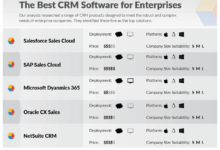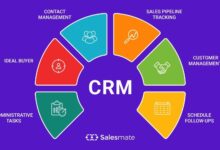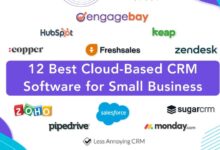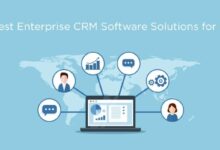CRM Software for Small Business Success
CRM Software for Small Business: Navigating the complexities of customer relationship management can feel overwhelming for small businesses. However, the right CRM system can streamline operations, boost sales, and foster stronger customer relationships, ultimately leading to significant growth. This guide explores the essential aspects of selecting, implementing, and utilizing CRM software tailored to the unique needs of small businesses.
From understanding core functionalities and budget considerations to mastering ease of use and scalability, we’ll cover everything you need to know to make an informed decision. We’ll delve into crucial features like contact management, sales automation, and customer service improvements, showcasing how these tools can transform your business. We also address vital topics such as data security and integration with other business tools, ensuring a holistic approach to CRM implementation.
Defining Needs for Small Business CRM
A Customer Relationship Management (CRM) system can be a game-changer for small businesses, streamlining operations and boosting efficiency. Choosing the right CRM, however, requires understanding your specific needs and how a CRM differs from simpler contact management solutions. This section will outline the core functionalities required, compare needs across various business types, and highlight key differentiating features.
Small businesses have diverse operational needs, and a CRM system should address these effectively. The core functionalities a small business requires depend heavily on its size, industry, and specific goals. However, some common necessities include contact management, lead tracking, sales pipeline management, and basic reporting capabilities.
Core Functionalities for Small Business CRM
Effective CRM for small businesses centers around managing customer interactions and improving sales processes. Essential features go beyond simple contact lists; they integrate various aspects of business operations.
- Contact Management: Centralized storage and organization of customer information, including contact details, communication history, and purchase records.
- Lead Tracking and Management: Tracking potential customers from initial contact through the sales process, including assigning leads to sales representatives and monitoring progress.
- Sales Pipeline Management: Visualizing the sales process, identifying bottlenecks, and improving sales conversion rates.
- Basic Reporting and Analytics: Generating reports on sales performance, customer behavior, and other key metrics to inform business decisions.
- Communication Tools: Integrating email, phone, and potentially social media communication channels for seamless customer interaction.
CRM Needs Across Different Small Business Types
The specific CRM requirements vary significantly depending on the nature of the small business. Retail, service, and consulting businesses have distinct needs.
| Business Type | Key CRM Needs | Example Features |
|---|---|---|
| Retail | Inventory management integration, point-of-sale (POS) system integration, customer purchase history tracking, loyalty program management. | Integration with Shopify, Square, or other POS systems; detailed transaction history; automated loyalty program features. |
| Service | Scheduling and appointment management, service history tracking, technician dispatch, customer feedback collection. | Calendar integration, automated appointment reminders, service ticket management, customer satisfaction surveys. |
| Consulting | Project management integration, time tracking, invoicing, client communication and collaboration tools. | Integration with project management software (Asana, Trello); time tracking features; automated invoicing; secure client portals. |
Differentiating CRM from Simple Contact Management
While simple contact management tools store contact information, CRMs offer far more extensive capabilities. The key differentiator lies in the integration of sales and marketing processes.
A CRM goes beyond simply storing names and numbers. It helps manage the entire customer journey, from initial contact to post-sale support. This includes features like lead scoring, sales pipeline visualization, and automated marketing campaigns, functionalities absent in basic contact managers.
Comparison of Popular Small Business CRM Software
Several CRM options cater to small businesses. The choice depends on specific needs and budget.
| CRM Software | Strengths | Weaknesses | Pricing |
|---|---|---|---|
| HubSpot CRM | Free plan available, extensive features, strong marketing automation capabilities. | Can be complex for users with limited technical skills; free plan has limitations. | Free plan, paid plans starting at a low monthly cost. |
| Zoho CRM | Affordable pricing, wide range of features, good customization options. | Interface can feel cluttered; customer support may not be as responsive as other options. | Various paid plans available at different price points. |
| Salesforce Essentials | Powerful features, robust reporting and analytics, excellent customer support. | Can be expensive for small businesses with limited budgets; steeper learning curve. | Priced higher than other options, but offers more comprehensive features. |
Budget and Pricing Considerations
Choosing the right CRM for your small business involves careful consideration of not only features but also the associated costs. Understanding the various pricing models and potential hidden expenses is crucial for making an informed decision that aligns with your budget and long-term financial goals. This section will explore various pricing structures, cost-effective options, negotiation strategies, and potential hidden costs to help you navigate the financial aspects of CRM implementation.
CRM Pricing Models
CRM software vendors offer a range of pricing models to cater to different business needs and budgets. The most common are subscription-based models and one-time purchase options. Subscription models typically involve recurring monthly or annual fees, often tiered based on the number of users, features included, and storage capacity. This provides predictable budgeting and access to ongoing updates and support. One-time purchases involve a single upfront payment for the software license, but usually lack ongoing support and updates, potentially leading to higher costs in the long run. Some vendors also offer hybrid models combining elements of both. For example, a vendor might offer a base level of functionality for a one-time fee, with additional features available through a subscription.
Cost-Effective CRM Solutions for Small Businesses
Several CRM solutions are specifically designed for startups and micro-businesses, offering affordable pricing and simplified functionality. Many offer free plans with limited features, allowing businesses to test the platform before committing to a paid subscription. Examples include HubSpot CRM (free plan available), Zoho CRM (various affordable plans), and Bitrix24 (free and paid options). These platforms often prioritize ease of use and essential features, eliminating unnecessary complexity and reducing the overall cost. The specific cost-effectiveness of each option depends on the individual business’s needs and the features they require.
Negotiating Favorable Pricing and Contract Terms
Negotiating with CRM vendors can lead to significant cost savings. Small businesses often have leverage by highlighting their long-term commitment or the potential for future growth. Clearly outlining your budget constraints and comparing quotes from multiple vendors strengthens your negotiating position. Focus on negotiating the contract length, the number of users included, and the features offered. Look for discounts for annual contracts or bulk purchases. It’s also beneficial to clearly define the service level agreement (SLA) and ensure it meets your business’s needs.
Hidden Costs Associated with CRM Implementation and Maintenance
While the initial software cost is important, several hidden costs can significantly impact your overall budget.
- Implementation and Customization Costs: Setting up the CRM, importing data, and customizing it to your specific workflows can require significant time and effort, potentially necessitating external consulting or training.
- Integration Costs: Connecting the CRM to other business software (e.g., accounting, email marketing) might involve additional fees or require specialized expertise.
- Data Migration Costs: Transferring existing customer data from legacy systems can be complex and time-consuming, potentially requiring professional services.
- Training Costs: Training your employees on how to use the CRM effectively is crucial for maximizing its benefits but may involve dedicated training sessions or online courses.
- Ongoing Maintenance and Support Costs: Beyond the initial purchase or subscription, ongoing maintenance, updates, and technical support can add up over time. Consider whether the vendor offers different levels of support and the associated costs.
- Add-on Costs: Many CRM providers offer add-on features (e.g., advanced reporting, automation tools) that can significantly increase the overall cost. Carefully evaluate your needs and avoid unnecessary add-ons.
Ease of Use and Implementation
Choosing the right CRM for your small business hinges significantly on its ease of use and the smoothness of its implementation. A user-friendly system will boost adoption rates amongst your team, leading to higher efficiency and a better return on your investment. Conversely, a complex and difficult-to-navigate system can lead to frustration, low usage, and ultimately, a failed CRM initiative.
Intuitive interfaces are paramount. Small businesses often lack dedicated IT staff, so the software needs to be easily grasped by employees with varying levels of technical expertise. Simple navigation, clear labeling, and readily accessible help resources are critical components of a successful CRM implementation.
CRM Onboarding Processes
The onboarding process is the initial phase of implementing your CRM. A streamlined and effective onboarding experience significantly reduces the learning curve and gets your team up and running quickly. Different CRM platforms offer varying levels of support during this phase. Some provide comprehensive tutorials, interactive guides, and dedicated onboarding specialists, while others might rely solely on written documentation. For example, Salesforce, known for its robust features, also offers extensive training resources and dedicated onboarding support, making the transition smoother for even less tech-savvy users. In contrast, a simpler CRM like HubSpot might offer a more intuitive interface that requires less formal training. The best approach depends on your team’s technical capabilities and your budget.
Integrating CRM with Existing Business Tools
Seamless integration with your existing business tools is essential for maximizing the benefits of a CRM system. This integration minimizes data entry duplication and ensures all your data resides in a single, unified view. For instance, integrating your CRM with your email client allows you to track email interactions directly within the CRM, providing a complete history of customer communication. Similarly, connecting your CRM to accounting software streamlines billing processes and provides a clear view of your revenue generated from each customer. The integration process can vary depending on the CRM and the tools you’re connecting. Some CRMs offer native integrations, while others might require third-party apps or custom development.
Step-by-Step Guide for Small Business CRM Implementation
Implementing a CRM system involves a structured approach to ensure a smooth transition. Here’s a typical step-by-step guide:
- Needs Assessment and Selection: Identify your business needs and select a CRM that aligns with those needs and your budget.
- Data Migration Planning: Plan how you will transfer existing customer data from your current systems (spreadsheets, databases, etc.) to the new CRM. This might involve manual data entry, importing from files, or using specialized data migration tools.
- System Configuration: Customize the CRM to match your business processes, including setting up user roles, defining workflows, and configuring automated processes.
- User Training: Provide comprehensive training to your team on how to use the CRM effectively. This could include online tutorials, workshops, or one-on-one sessions.
- Go-Live and Monitoring: Launch the CRM and closely monitor its performance. Gather feedback from your team and make adjustments as needed to optimize its usage.
- Ongoing Optimization: Regularly review and optimize your CRM usage to ensure it continues to meet your evolving business needs.
Key Features and Functionality
A robust CRM system for small businesses isn’t just about storing contact information; it’s about integrating tools that streamline operations, boost sales, and enhance customer relationships. The right features can significantly improve efficiency and profitability. This section will explore key functionalities crucial for small business success.
Contact Management in Small Business CRM
Effective contact management is the cornerstone of any successful CRM strategy. A CRM system centralizes all customer interactions, providing a single source of truth for vital information. This eliminates the need for scattered spreadsheets, email threads, and sticky notes, reducing the risk of missed opportunities and improving overall communication. Small businesses can use this feature to segment their customer base, track interactions, and personalize communications, fostering stronger customer relationships and improving retention rates. For instance, a bakery could segment its customer base by preferences (e.g., gluten-free, vegan) to send targeted promotions and offers.
Sales Automation Features and Their Impact on Productivity and Revenue
Sales automation tools within a CRM system significantly enhance productivity and drive revenue growth. These tools automate repetitive tasks such as email marketing, lead nurturing, and follow-up communications, freeing up valuable time for sales representatives to focus on building relationships and closing deals. Features like automated email sequences can nurture leads, sending personalized messages at predetermined intervals, increasing the likelihood of conversion. A clothing retailer, for example, could use automated emails to send abandoned cart reminders, potentially recovering lost sales. Furthermore, sales pipeline management tools within the CRM provide a clear view of the sales process, enabling better forecasting and resource allocation.
Utilizing CRM Software for Improved Customer Service and Support
A CRM system can dramatically improve customer service and support. By centralizing customer interactions, support teams can access a complete history of each customer’s engagement with the business. This allows for personalized and efficient support, resolving issues quickly and effectively. Features like integrated ticketing systems and knowledge bases further streamline the support process, empowering agents to provide prompt and accurate solutions. For example, a tech support company could use a CRM to track customer issues, assign tickets to appropriate agents, and monitor resolution times, ensuring a consistent and high-quality customer experience. This improved service fosters customer loyalty and positive word-of-mouth referrals.
Reporting and Analytics for Performance Tracking and Improvement Identification
Reporting and analytics features within a CRM provide valuable insights into business performance. These features allow small businesses to track key metrics such as sales conversion rates, customer acquisition costs, and customer lifetime value. By analyzing this data, businesses can identify areas for improvement, optimize sales strategies, and make data-driven decisions. For example, a restaurant could use CRM analytics to track customer feedback, identify popular menu items, and understand customer preferences, informing menu adjustments and marketing campaigns. This data-driven approach allows for continuous improvement and maximizes the return on investment in the CRM system.
Scalability and Future Growth
Choosing a CRM system that can adapt to your business’s growth is crucial for long-term success. A system that works well for a small startup may become a bottleneck as the company expands, leading to inefficiencies and hindering further development. Investing in a scalable solution from the outset minimizes the disruption and cost associated with future migrations.
Investing in a scalable CRM ensures that your system can handle increasing amounts of data, users, and functionalities without significant performance degradation. This avoids the need for frequent upgrades or complete system replacements, saving both time and money. Scalability also ensures that your CRM can adapt to evolving business needs, such as integrating with new software or supporting new sales channels.
Factors Affecting CRM Scalability
Several key factors influence a CRM system’s ability to scale. These factors should be carefully considered during the selection process to ensure a long-term fit with the business’s growth trajectory.
- Data Storage Capacity: The CRM must be able to handle the growing volume of customer data, contact information, sales transactions, and other relevant information as the business expands. Cloud-based solutions generally offer better scalability in this regard than on-premise systems.
- User Capacity and Management: The system should accommodate a growing number of users, including sales representatives, customer service agents, and marketing personnel, without impacting performance. Robust user management features are essential for controlling access and permissions.
- Integration Capabilities: A scalable CRM should seamlessly integrate with other business applications, such as accounting software, marketing automation tools, and e-commerce platforms. This ensures data consistency and streamlines workflows as the business expands its technological infrastructure.
- System Architecture: The underlying architecture of the CRM plays a critical role in its scalability. Cloud-based solutions with a modular architecture tend to offer better scalability compared to monolithic systems.
- Customization Options: As the business grows and its needs evolve, the CRM should allow for customization without requiring significant re-engineering. This flexibility is essential for adapting to changing business processes and integrating new functionalities.
Challenges of CRM Data Migration
Migrating data to a new CRM system can be a complex and time-consuming process, particularly as the business grows and the data volume increases. Data inconsistencies, incomplete data, and data loss are potential risks. Furthermore, ensuring data accuracy and integrity during the migration process is paramount to maintain business continuity.
CRM System Upgrade/Switch Flowchart
The following flowchart illustrates the typical steps involved in upgrading or switching CRM systems to accommodate business expansion:
[Diagram Description: The flowchart would begin with a “Start” box. This would branch into two decision boxes: “Is the current CRM scalable enough?” and “Is a CRM upgrade feasible?”. A “Yes” answer to the first question would lead to a “Continue with current CRM” box. A “No” answer would lead to a path starting with a “Needs Assessment” box, followed by “CRM Selection”, “Data Migration Planning”, “Data Migration Execution”, “System Testing”, “Go-Live”, and finally “Post-Implementation Review”. A “No” answer to the second question (regarding upgrade feasibility) would lead directly to “CRM Selection” and then follow the same path as the “No” answer to the first question. All boxes would be connected by arrows indicating the flow.]
Security and Data Protection
Protecting your customer data is paramount for any business, but especially crucial for small businesses relying on strong customer relationships. A breach of sensitive information can severely damage your reputation, lead to financial losses, and even result in legal repercussions. Choosing a CRM system with robust security features is therefore a non-negotiable aspect of selecting the right software for your needs.
A secure CRM system acts as a safeguard, protecting your valuable customer data from unauthorized access, loss, or alteration. This not only protects your business but also builds trust with your customers, demonstrating your commitment to responsible data handling.
Security Measures Offered by CRM Providers
Reputable CRM providers offer a range of security measures to protect sensitive customer data. These measures often include data encryption both in transit (while data is traveling between systems) and at rest (while data is stored on servers), multi-factor authentication (requiring multiple forms of verification to access the system), regular security audits and penetration testing to identify and address vulnerabilities, and robust access controls to limit who can view and modify specific data. Some providers also offer features like IP address restrictions, limiting access based on the location of the user’s computer. Compliance with industry standards like GDPR and CCPA is also a key indicator of a provider’s commitment to data security.
Steps Small Businesses Can Take to Ensure CRM Data Security
Beyond relying on the security features provided by your CRM vendor, small businesses should proactively implement their own security measures. This includes developing and enforcing strong password policies for all users, regularly updating the CRM software and its underlying operating system to patch security vulnerabilities, and educating employees about phishing scams and other social engineering attacks that could compromise the system. Implementing a data backup and recovery plan is also essential to mitigate the impact of data loss due to accidental deletion, hardware failure, or malicious attacks. Regularly reviewing user access permissions ensures that only authorized individuals have access to sensitive data.
Best Practices for Managing User Access and Permissions
Effective management of user access and permissions is critical for maintaining the security of your CRM data. This involves assigning roles and permissions based on an individual’s job responsibilities, granting only the minimum necessary access to sensitive information, and regularly reviewing and updating these permissions as employee roles change. Implementing a principle of least privilege—granting only the necessary permissions to each user—is a fundamental security best practice. Regularly auditing user activity within the CRM system can help identify suspicious behavior and potential security breaches. Strong password policies, including password complexity requirements and regular password changes, are also crucial components of a robust access control strategy. Finally, documenting all access control procedures ensures consistency and facilitates troubleshooting.
Integration with other Business Tools
A small business CRM’s effectiveness is significantly amplified when integrated with other essential business tools. Seamless data flow between different systems streamlines operations, reduces manual data entry, and provides a more holistic view of your business. This integration allows for a more efficient and informed approach to customer relationship management.
Integrating your CRM with other platforms offers several key advantages. By connecting your CRM to your email marketing platform, you can personalize marketing campaigns based on customer interactions and preferences recorded within the CRM. Linking it to your accounting software automates invoice generation and payment tracking, providing real-time financial insights tied directly to customer relationships. Integration with e-commerce platforms offers a unified view of customer journeys, from initial website visit to purchase and beyond, facilitating targeted marketing and improved customer service.
Examples of Common Integrations
Many popular CRM systems offer pre-built integrations or APIs (Application Programming Interfaces) that enable connections with various business tools. For example, Salesforce integrates with popular email marketing platforms like Mailchimp and Constant Contact, accounting software such as QuickBooks and Xero, and e-commerce platforms including Shopify and Magento. Similarly, HubSpot CRM integrates with Google Workspace, allowing for seamless email management and contact synchronization, and with various marketing automation tools. Zoho CRM offers a wide range of integrations covering email marketing, accounting, and e-commerce, as well as social media platforms.
Challenges of System Integration and Strategies for Overcoming Them
While integration offers significant benefits, challenges can arise. Data inconsistencies between systems, differing data formats, and the complexity of setting up and maintaining integrations are common hurdles. To overcome these, thorough planning is crucial. This includes clearly defining data mapping between systems, choosing reliable integration tools or methods (such as APIs or middleware), and implementing robust data validation processes to ensure data accuracy and consistency across all integrated systems. Regular testing and monitoring of the integrated systems are also essential to identify and address any issues promptly. Investing in professional services to manage complex integrations can also be beneficial, particularly for businesses lacking the internal expertise.
Comparison of CRM Software Integration Capabilities
| CRM Software | Email Marketing | Accounting Software | E-commerce Platforms |
|---|---|---|---|
| Salesforce | Mailchimp, Constant Contact, Pardot | QuickBooks, Xero, NetSuite | Shopify, Magento, WooCommerce |
| HubSpot | HubSpot Marketing Hub | Xero, QuickBooks | Shopify, WooCommerce |
| Zoho CRM | Zoho Campaigns | Zoho Books | Shopify, Magento |
| Microsoft Dynamics 365 | Microsoft Dynamics 365 Marketing | Microsoft Dynamics 365 Finance | Various integrations available via AppSource |
Customer Support and Training
For small businesses, the success of a CRM system hinges not only on its features but also on the ease with which employees can adopt and effectively utilize it. Readily available and comprehensive customer support and training resources are crucial for maximizing ROI and ensuring a smooth transition to the new system. Without proper support, even the most powerful CRM can become a costly, underutilized asset.
Effective customer support and training programs empower small business employees to confidently manage customer interactions, streamline workflows, and ultimately, drive business growth. This translates to increased efficiency, improved customer satisfaction, and a stronger bottom line. The right support infrastructure helps mitigate common challenges, reduces frustration, and ensures a positive user experience.
Support Channels Offered by CRM Providers
CRM providers typically offer a variety of support channels to cater to different user preferences and needs. These channels are designed to provide timely and effective assistance when users encounter issues or require guidance.
- Phone Support: Provides immediate, personalized assistance for urgent problems or complex inquiries. A dedicated phone line allows for real-time troubleshooting and direct interaction with a support representative.
- Email Support: Offers a convenient way to submit detailed questions or reports, allowing users to articulate their issues thoroughly and receive a considered response. This channel is particularly suitable for non-urgent issues.
- Online Chat: Provides quick, real-time support for immediate queries or troubleshooting simple problems. The instant nature of chat makes it ideal for quick solutions.
- Knowledge Base/Help Center: A comprehensive repository of articles, FAQs, tutorials, and videos, addressing common issues and providing step-by-step instructions. This self-service option empowers users to resolve many issues independently.
Elements of Effective CRM Training Programs
Effective CRM training programs are designed to equip small business employees with the knowledge and skills needed to use the system efficiently and effectively. A well-structured program minimizes the learning curve and maximizes user adoption.
- Interactive Training Modules: These modules use a blend of text, images, and videos to explain concepts and features in an engaging and easy-to-understand manner. Interactive elements, such as quizzes and exercises, reinforce learning and assess comprehension.
- Hands-on Workshops: These sessions provide a practical learning experience, allowing employees to work with the CRM software in a guided environment. This approach helps solidify understanding and build confidence.
- Personalized Coaching and Mentoring: One-on-one support can address individual challenges and provide customized guidance. This personalized approach is particularly beneficial for users who require additional assistance.
- Ongoing Support and Refresher Courses: As the CRM system evolves, or as employees’ roles change, ongoing support and refresher courses ensure users stay up-to-date with the latest features and best practices. This helps maintain proficiency and prevent skill gaps.
Characteristics of Good CRM Support Documentation
Comprehensive and well-organized support documentation is essential for users to find answers quickly and efficiently. Effective documentation plays a critical role in empowering users to resolve issues independently and maximizing the value of the CRM system.
- Easy-to-Navigate Structure: Information should be logically organized and easily accessible through a clear search function and intuitive menu system. Users should be able to quickly find the information they need.
- Clear and Concise Language: Documentation should be written in plain language, avoiding technical jargon. The language should be easy to understand for users with varying levels of technical expertise.
- Comprehensive Coverage: Documentation should cover all aspects of the CRM system, including setup, configuration, features, and troubleshooting. This ensures that users have access to the information they need to use the system effectively.
- Regular Updates: As the CRM system evolves, the documentation should be updated to reflect changes and additions. This ensures that the information remains accurate and relevant.
Ending Remarks
Implementing the right CRM software can be a game-changer for small businesses. By carefully considering your specific needs, budget, and long-term goals, you can select a system that empowers your team, enhances customer interactions, and drives sustainable growth. Remember to prioritize user-friendliness, robust security features, and seamless integration with existing tools. With the right CRM in place, your small business is well-positioned to thrive in today’s competitive landscape.





